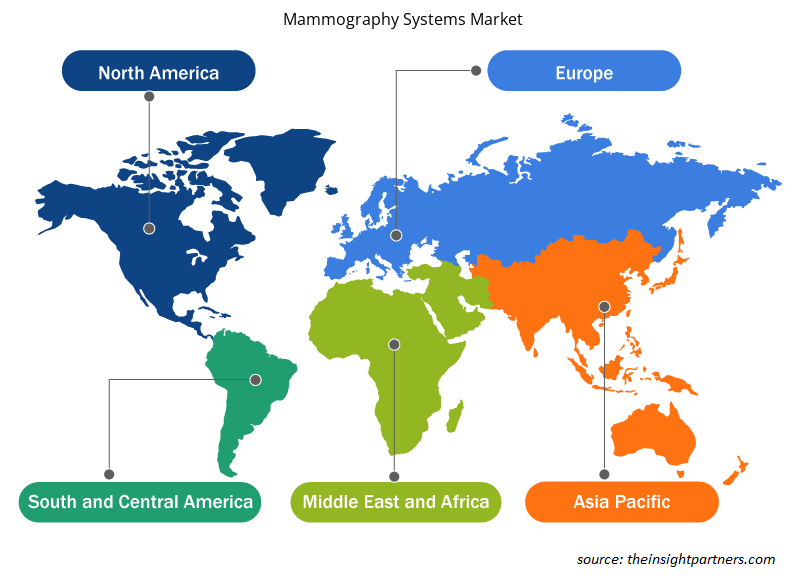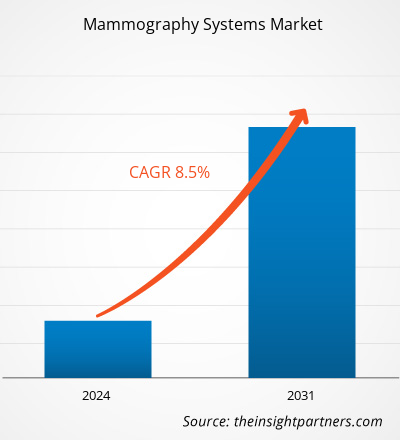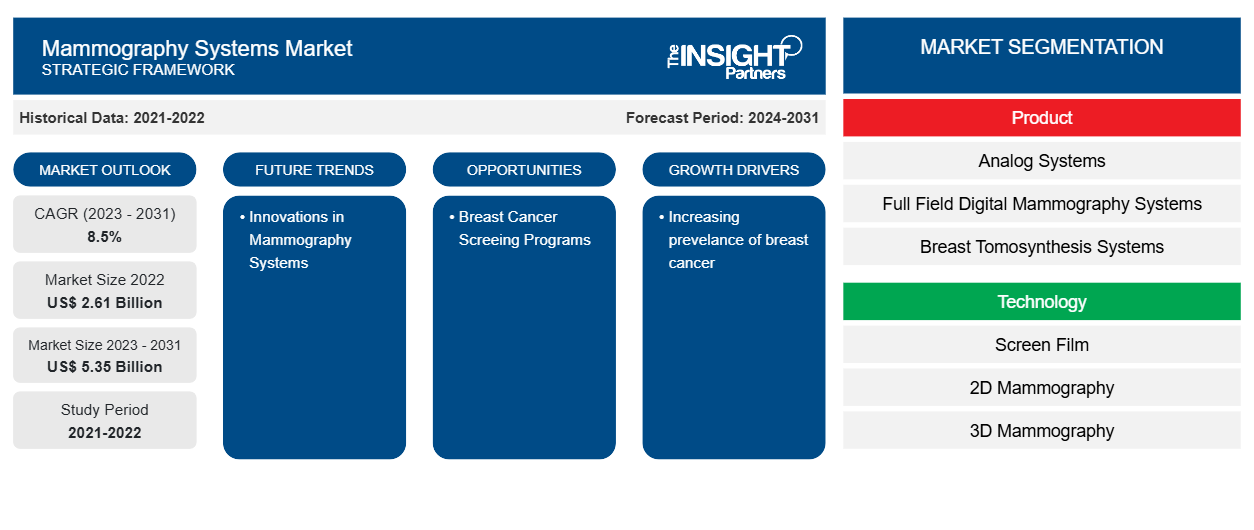预计到 2031 年,乳房 X 线摄影系统市场规模将从 2022 年的 26.1 亿美元增至 53.5 亿美元。预计 2023-2031 年市场复合年增长率将达到 8.5%。乳房 X 线摄影系统创新的不断增加以及市场参与者之间的合作推动了新产品的推出,这些产品很可能仍是乳房 X 线摄影系统市场的主要趋势。
乳房X光照射系统市场分析
乳腺癌的发病率在世界范围内不断增长,导致对用于诊断的乳房 X 线摄影系统的需求增加。乳腺癌的一些常见症状包括乳头内陷、乳房形状改变、乳房肿块、皮肤出现红色或鳞状斑块或乳头疼痛。根据乳腺癌组织的报告,2023 年,乳腺癌占全球报告的癌症病例总数的 12.5%。此外,每年女性新诊断癌症中约有 30% 是乳腺癌。根据同一来源,预计 2023 年男性将诊断出 2,800 名新乳腺癌患者。因此,全球乳腺癌在大量人口中的发病率不断上升,预计将产生对诊断和治疗的需求,从而支持乳房 X 线摄影系统市场的增长。
乳房X光照射系统市场概况
乳腺癌是全球最常见的癌症之一,影响着大量人口。乳腺癌的患病率和发病率不断上升,对准确诊断和有效治疗方案的需求也随之增加。癌症患病率的不断上升增加了研究活动资金和补助金,以提高全球诊断率,从而提供及时治疗。此外,全球市场上有各种市场参与者专注于开发先进的诊断系统,这导致产品发布和合作增加,进而促进了乳房 X 线摄影系统市场的增长。
定制此报告以满足您的需求
您可以免费定制任何报告,包括本报告的部分内容、国家级分析、Excel 数据包,以及为初创企业和大学提供优惠和折扣
- 获取此报告的关键市场趋势。这个免费样品将包括数据分析,从市场趋势到估计和预测。
乳房 X 线摄影系统的市场驱动因素和机遇
增加政府和社会资本投资、补助和基金以利于市场
过去几年,针对乳腺癌早期检测的研究活动的投资有所增加。例如,2023 年 5 月,维多利亚州医疗加速基金拨款帮助维多利亚州乳腺筛查中心开发设施并开展研究活动,以利用人工智能 (AI) 读取乳房 X 光片。
美国乳腺成像学会致力于将乳腺癌的影响降到最低,挽救患者的生命。该学会设有研究与教育基金计划,旨在为乳腺成像研究和教育提供资金支持。此外,在英国,政府承诺额外投资 1249 万美元,用于建立 29 个新的乳腺癌筛查中心和约 70 个用于治疗和诊断乳腺癌的救命发展项目。
因此,增加公私投资、补助和资金为乳房X光照射系统市场提供了增长动力。
乳腺癌筛查项目——乳房 X 线摄影系统市场的机会
预防性医疗保健和疾病诊断计划的日益实施为乳房 X 线摄影系统市场参与者创造了丰厚的增长机会。例如,加拿大所有省份都为 50-74 岁的女性提供乳腺癌筛查计划。不列颠哥伦比亚省卫生服务管理局有一个乳腺癌筛查计划,为大量人口提供简单、廉价的测试;该计划主要旨在早期诊断乳腺癌。
此外,2023 年 11 月,富士胶片印度公司在全国癌症宣传日发起了一项实地乳腺癌筛查和宣传活动,以促进早期乳腺癌检测。富士胶片印度公司承诺与配备先进乳房 X 线摄影系统的 35 家尖端诊断中心合作,在 19 个城市开展这项计划。
乳房 X 线摄影系统市场报告细分分析
有助于得出乳房 X 线摄影系统市场分析的关键部分是产品、技术和最终用户。
- 根据产品,乳房 X 线摄影系统市场分为全视野数字乳房 X 线摄影系统、乳房断层合成系统和模拟系统。全视野数字乳房 X 线摄影系统部分在 2023 年占据了更大的市场份额。
- 根据技术,市场分为屏幕胶片、2D 乳房 X 线摄影、3D 乳房 X 线摄影等。2023 年,2D 乳房 X 线摄影技术占据了最大的市场份额。
- 就最终用户而言,市场分为医院、门诊手术中心和其他。其他部分在 2023 年占据了市场主导地位。
乳房 X 线照相系统市场份额(按地区)分析
乳房 X 线摄影系统市场报告的地理范围主要分为五个地区:北美、亚太地区、欧洲、中东和非洲、南美和中美。
由于先进医疗设备的采用日益广泛、技术进步和乳腺癌患病率上升,北美在乳房 X 线摄影系统市场占据主导地位,预计将加速乳房 X 线摄影系统市场的增长。由于先进医疗设备技术的采用日益广泛、医疗设备数字化程度不断提高、对改善治疗结果的重视程度不断提高以及乳腺癌患病率不断上升,美国在 2023 年占据了最大的市场份额。美国乳腺癌患病率的上升可能会对乳房 X 线摄影系统产生需求。根据乳腺癌组织的乳腺癌统计数据,乳腺癌占全球每年所有新发癌症病例的 12.5%。此外,预计 2023 年美国女性将诊断出约 297,790 例新的浸润性乳腺癌病例,以及 55,720 例新的 DCIS 病例。此外,预计亚太地区未来几年的复合年增长率最高。
乳房X光照射系统市场区域洞察
Insight Partners 的分析师已详尽解释了预测期内影响乳房 X 线摄影系统市场的区域趋势和因素。本节还讨论了乳房 X 线摄影系统市场的各个部分和地理位置,包括北美、欧洲、亚太地区、中东和非洲以及南美洲和中美洲。

- 获取乳房X光照射系统市场的区域特定数据
乳房 X 线摄影系统市场报告范围
| 报告属性 | 细节 |
|---|---|
| 2022 年市场规模 | 26.1亿美元 |
| 2031 年市场规模 | 53.5亿美元 |
| 全球复合年增长率(2023 - 2031) | 8.5% |
| 史料 | 2021-2022 |
| 预测期 | 2024-2031 |
| 涵盖的领域 | 按产品
|
| 覆盖地区和国家 | 北美
|
| 市场领导者和主要公司简介 |
|
乳房 X 线摄影系统市场参与者密度:了解其对业务动态的影响
乳房 X 线摄影系统市场正在快速增长,这得益于终端用户需求的不断增长,而这些需求又源于消费者偏好的不断变化、技术进步以及对产品优势的认识不断提高等因素。随着需求的增加,企业正在扩大其产品范围,进行创新以满足消费者的需求,并利用新兴趋势,从而进一步推动市场增长。
市场参与者密度是指在特定市场或行业内运营的企业或公司的分布情况。它表明在给定市场空间中,相对于其规模或总市场价值,有多少竞争对手(市场参与者)存在。
在乳房 X 线摄影系统市场运营的主要公司有:
- 锐珂医疗公司
- 通用电气公司
- Hologic 公司
- 荷兰皇家飞利浦公司
- 普兰梅德
- 富士胶片公司
免责声明:上面列出的公司没有按照任何特定顺序排列。

- 了解乳房 X 线摄影系统市场主要参与者概况
乳房 X 线摄影系统市场新闻和最新发展
乳房 X 线摄影系统市场通过收集初级和二级研究后的定性和定量数据进行评估,其中包括重要的公司出版物、协会数据和数据库。以下是乳房 X 线摄影系统和策略市场发展的列表:
- 该公司推出了 Mammomat B.brilliant,这是一款具有广角断层合成功能的新型乳房 X 线摄影系统。在断层合成中,管子以 50° 的广角围绕乳房移动,这是市场上最大的角度,使其成为乳房 X 线摄影的绝佳工具。(来源:西门子医疗股份公司,新闻稿,2023 年)
- 该公司推出了名为 MyBreastAI Suite 的一体化人工智能 (AI) 应用平台,帮助临床医生检测乳腺癌并提高工作流程效率。MyBreastAI Suite 的初始版本集成了 iCAD 的三款 AI 应用程序,包括用于 DBT 的 ProFound AI、用于 2D 乳房摄影的 SecondLook 和 PowerLook 密度评估,以帮助支持早期检测和改善患者结果,并帮助放射科提高运营效率。(来源:GE HealthCare,新闻稿,2023 年)
- 该公司推出了其 Amulet Innovality 乳房 X 线摄影系统的全新“Harmony”版本。“Harmony”版本将改进的诊断性能与新的设计主题结合在一起,以美化和照亮您的乳房 X 线摄影套件,营造出让患者感到舒适的环境。(来源:HiE,通讯,2021 年)
乳房 X 线摄影系统市场报告覆盖范围和交付成果
“乳房 X 线摄影系统市场规模和预测(2021-2031 年)”报告对市场进行了详细分析,涵盖以下领域:
- 范围内涵盖的所有主要细分市场的全球、区域和国家层面的市场规模和预测
- 市场动态,如驱动因素、限制因素和关键机遇
- 未来主要趋势
- 详细的 PEST/波特五力分析和 SWOT 分析
- 全球和区域市场分析涵盖关键市场趋势、主要参与者、法规和最新市场发展
- 行业格局和竞争分析,涵盖市场集中度、热点图分析、知名参与者和最新发展
- 详细的公司简介
- 历史分析(2 年)、基准年、预测(7 年)及复合年增长率
- PEST和SWOT分析
- 市场规模、价值/数量 - 全球、区域、国家
- 行业和竞争格局
- Excel 数据集
近期报告
客户评价
购买理由
- 明智的决策
- 了解市场动态
- 竞争分析
- 客户洞察
- 市场预测
- 风险规避
- 战略规划
- 投资论证
- 识别新兴市场
- 优化营销策略
- 提升运营效率
- 顺应监管趋势





















 获取免费样品 - 乳房X光摄影系统市场
获取免费样品 - 乳房X光摄影系统市场